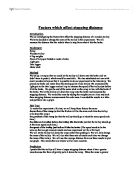Heightening objects (books) – for slope of ramp
Plan: - Weigh the trolley and the brake block and record (for use in the scientific formula). Carry out a preliminary test to discover any previously unseen problems, decide the best gradient for the slope, put all element of FAIR TEST into practice and make sure no more should go into consideration. Check to see if the scientific formulae are accurate and if they aren’t, why?
Write down any changes I will make to the actual experiment and why.
Carry out the experiment accurately and record all the results in a table
Draw graphs and make a conclusion from my experiment.
Fair Test: - To ensure that all my results are accurate I had to consider what would make the experiment fair.
Always use the same trolley, brake block, ramp and elastic, ribbon for brake, Newton meter and height altering object because even the slightest change could have an effect on the final results. Nothing will be interfered or tampered with during the experiment and the trolley must always have a clear run down the slope. The slope must be stable and the experiment must be carried out indoors with little breeze (an increase in air resistance could change things). Measurements must always be made accurately. Everything must be kept consistent other than the brakes!
Weights: -
Brake Block – 85 grams
Trolley – 1466 grams
The stretch on the elastic on the catapult before propelling the trolley must be 7.5 Newtons.
Formula: - From looking at scientific research I know that the amount of kinetic energy that is produced is equal to half of the mass of the vehicle multiplied by the velocity of the vehicle squared.
Kinetic Energy = half mass x (velocity)²
K.E. = 1/2MV
By using the above formula I can work out the braking distance
To find out the maximum velocity of the trolley we didn’t use any brakes (because it is maximum). We obviously did deal with time. We did this very accurately using Light Gates and a computer. These are the results:
Try 1 Try 2 Try 3 Average
1.75 1.71 1.79 1.75
secs secs secs secs
It took an average of 1.75 seconds to travel the distance of the ramp from the catapult to the end.
Example: - If the trolley I was using weighed 50gms and travels a maximum speed of 5.0 meters a second I would know the kinetic energy the trolley had transformed is 625 Joules
K.E. = 25 Kg x 5²
= 25 Kg x 25
= 625 Joules
Prediction: - The more pressure being put onto the brake block, the less distance it will take to stop the trolley
Picture: -
Potential energy that is stored in the elastic (when it is pulled back 27cm (7.5 Newtons of force) and when the elastic is released it is changed into kinetic energy which moves the trolley along the ramp. The brake force comes into action when the catapult is no longer touching the trolley and there is no slack in the brake ribbon. The amount of weights acting on the brake block determines how quickly the trolley will stop.
In an ideal situation the work done by the brakes should equal the potential energy of the catapult.
Preliminary Test: - 100 grams – went off edge of ramp
200grams – travelled 108.5cm
300grams – travelled 71.5cm
400 grams – travelled 56 cm
500 grams – travelled 43.5 cm
Any Changes: - I have decided to tilt the ramp at 10º because this is just the right amount of tilting to compensate for air resistance, friction on the bearings and friction on the slope. I could tell this because using light gates and the computer to measure the trolley’s speed I could tell when the trolley was running at a consistant speed. E.g. At 5° the vehicle was a different speed depending on where it was on the ramp.
I am starting the experiment with a 1 Newton weight on top of the brakes (with extra plasticine) because otherwise the trolley would have gone off the edge of the ramp and I wouldn’t have been able to record the distance the trolley had travelled accurately. Therefore I have decided that the first experiment will have a 1 Newton weight on top the brake block (and plasticine.) This gives a combined weight of the brake of 200grams / 2 Newtons
Results: -
Conclusion: - The evidence shows that my prediction was right and the weight on the brake block has a considerable effect on how quickly the trolley will stop moving forward; the greater the weight, the shorter the stopping distance.
Evaluation: - The test went well. If I were to do it again I would probably test different sorts of brakes to discover which were the most effective.
We could have done more than 3 tries for the test, which would have made the average more accurate (although it is quite accurate already.) I might redo the 200gram experiment again as this is the most varied of all of the results from the 3 tries. By using brand new equipment I could have made the results more consistent.







